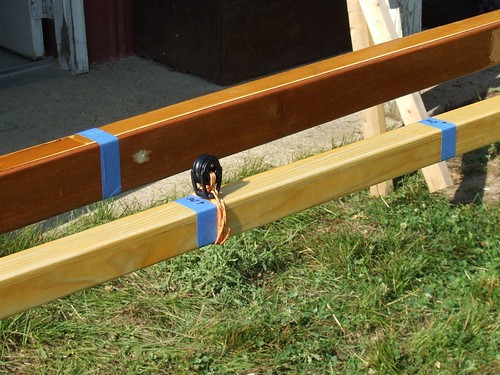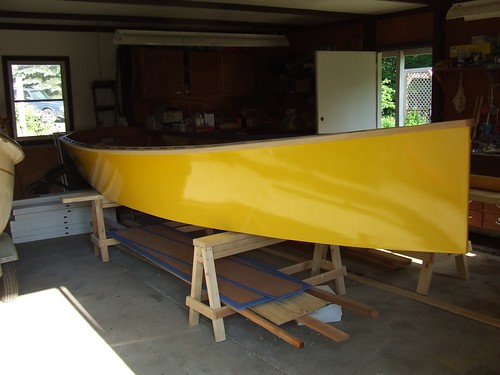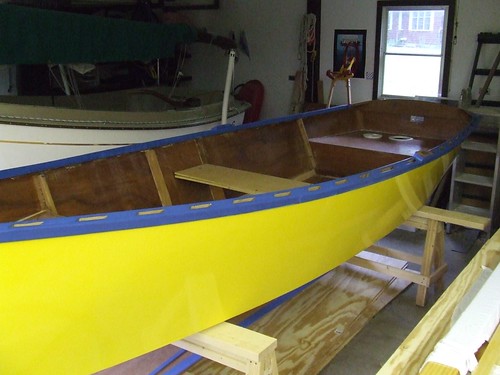 Thanks: 0
Thanks: 0
 Needs Pictures: 0
Needs Pictures: 0
 Picture(s) thanks: 0
Picture(s) thanks: 0
Results 646 to 660 of 724
Thread: GIS - Sacramento
-
26th June 2011, 07:39 AM #646
-
26th June 2011 07:39 AM # ADSGoogle Adsense Advertisement
- Join Date
- Always
- Location
- Advertising world
- Age
- 2010
- Posts
- Many
-
26th June 2011, 01:15 PM #647

Hi Rick!
Thanks. It has taken me awhile, but I am finally finishing out my GIS.
What have you been up to?Building Gardens of Fenwick, a Welsford Parthfinder
Gardens of Fenwick
Karen Ann, a Storer GIS
Goat Island Skiff - Sacramento
-
26th June 2011, 01:36 PM #648

As work proceeds toward completion - at least to the point of sailing - I have a couple of questions
The first is based on the following two quotes:
From Bruce (March 12, 2011):
From Brian (July 7, 2010):As for the correct tension along the yard, I have found there is only one way to adjust this properly. If you haven't yet fixed an eye or a saddle to the yard for the throat attachment, do that first. A stainless steel saddle bolted through with small bolts will ensure it is strong enough to cope with the considerable luff tensions. Shackle the throat to that. This is essential to prevent transmitting the luff tension through to the yard and to the peak, and keeps the adjustment totally separate.
1. Are Bruce and Brian addressing the same issue? If I put the throat lashing hole aft/above the throat will that have the same effect as shackling the throat to a padeye/saddle?The hole is below the throat clew so serves no purpose in stopping the throat moving downwards - it's below it so cannot do its job. The lashing may be holding just about but nothing is really stopping it sliding downwards.
With just one hole then the clew has to be lashed close to the hole, the clew will then drop slightly below the hole as tension is applied.
In my view is should be lashed as with all corner lashings as you draw - one element holding to the boom and one element preventing sliding along the boom.
The next questions are not based on the above quotes; I am just making sure I read things correctly and to make sure nothing has changed :
2. The block on the yard is to be located at the mid-point of the yard, correct?
3. The fairlead for the halyard is to be placed as high on the mast as possible, correct?
I think that is it for now. I'm sure there will be more questions over the next few days.
Thanks.Building Gardens of Fenwick, a Welsford Parthfinder
Gardens of Fenwick
Karen Ann, a Storer GIS
Goat Island Skiff - Sacramento
-
26th June 2011, 02:37 PM #649

I think Bruce was describing the forces at play and Bruce offered a specific solution to resolving them.
If I'm not mistaken, the halyard block is placed more like 40% from the throat, at least as a start. With time you'll probably tweak it from there so using a lashing rather than a screwed in block is prudent to start.
MIK is no too specific on placement of the fairlead (or even what to use there). Consider that the closer you get to the tip, the less strength there is. I plan to attach mine at least two or three inches from the tip. It probably not a critical measure or MIK would have stated it to the tenth of a millimeter!
Sent from my iPhone using TapatalkDave
StorerBoat Builder, Sailor, Enthusiast
Dave's GIS Chronicles | Dave's Lugs'l Chronicles | Dave's StorerBoat Forum Thread
-
26th June 2011, 11:00 PM #650

Thanks, Dave.
The basis for my question comes from Mik's Goat Island Skiff - Rig and rigging details for efficient lug sails:
Goat Island Skiff (GIS) - systems for lug sails and rigs - Michael Storer Wooden Boat Plans
The section, The Mainsail Halyard, contains the statement, "The block is attached to the midpoint of the yard using a rope loop as above." One of the captions on the photo in the rigging guide repeats the midpoint location. However, I have seen a comment re attaching the block at 40% but I don't recall if that involved basic set up or reefing (and I cannot find that/those references.) If the block position has evolved, great. I was asking to clarify my confusion.
Almost time to get back to painting. Building Gardens of Fenwick, a Welsford Parthfinder
Building Gardens of Fenwick, a Welsford Parthfinder
Gardens of Fenwick
Karen Ann, a Storer GIS
Goat Island Skiff - Sacramento
-
27th June 2011, 02:36 AM #651

I've been fighting with the homeowner's association where I live over the use of my garage as a workshop....long story but in the end I won that battle, much to their irritation, and also fighting in this crappy economy to keep a roof over my head. That's been pretty much a full time occupation the last 2 years, but things are definitely looking up on that front.
-
27th June 2011, 08:07 AM #652

Hi Bob
Just checking in. Great progress with your sail and spars!
Brian and I do address the same issue. It's essential that the throat is immovable, which is impossible if using just the one hole for lashing. As I have an aluminium yard, I chose the saddle (like Brian on his Scow), which by the way would be an excellent solution for a timber yard as well if the saddle is through bolted.
As for the position of the halyard attachment on the yard, start at the 40% position and then go from there, depending on your sail and boat tuning. The correct point will be somewhere between 40 and 50%. It needs to change when you put in a reef anyway, so just use a sliding lash point. You can make marks for the locations of the lash points for each reef point. (You don't want to be drilling holes in the middle of your yard anyway as it increases the likelihood that it will break)
-
27th June 2011, 11:50 AM #653

Rick,
Winning that battle with the HOA is GREAT! Glad to hear things are looking up. Hopefully, you will be able to put that victory to use and build another boat.
BobBuilding Gardens of Fenwick, a Welsford Parthfinder
Gardens of Fenwick
Karen Ann, a Storer GIS
Goat Island Skiff - Sacramento
-
27th June 2011, 12:10 PM #654

Bruce,
Thanks for the response and the compliments. I won't quit my day-job to become a sailmaker but I am satisfied enough with the sail to want to build another one (yeah, that probably involves building another boat. )
)
Do you shackle the throat to the saddle and lash the sail to the yard - or just shackle it? I'm ready to rig the yard and boom. If through-fastening a saddle eliminates the need for the lashing hole, I would much rather install the saddle and skip drilling a large hole in the yard. (I know, I need one for the halyard.) Also, how do you shackle the throat close enough to the yard? Maybe I need to sort through the rigging posts again.
Thanks for the info re placement of the yard block. I'm not drilling holes in the yard to install the block. I am using a lashing to attach the yard block so mid-point, 40% or some other location does not matter much.

In other developments, the final (I think) color coat went on late this morning in nearly ideal conditions. After supper my sister, her husband and a neighbor couple helped me turn the boat over.

Seeing her upright after so many months of her being upside down gives me a fresh perspective and appreciation for her natural good looks. Tomorrow I'll begin some interior work - which includes painting the gunwale.
Building Gardens of Fenwick, a Welsford Parthfinder
Tomorrow I'll begin some interior work - which includes painting the gunwale.
Building Gardens of Fenwick, a Welsford Parthfinder
Gardens of Fenwick
Karen Ann, a Storer GIS
Goat Island Skiff - Sacramento
-
27th June 2011, 09:47 PM #655

She is looking such a peach!
Bob, the attachment is nothing more than a shackle through the eye of the throat and directly to the saddle. You will find that the sail is held close to the yard. As for the lashing, the best solution by far is nylon cable ties, because they are strong and they slide nicely on the yard. It's easy to get the right tension. Just nip them enough so that the sail just touches against the yard. Christophe has gone this way now too.
As for the lashing, forget about that block, you don't need it as the halyard does not ever move through it. It remains static. Just make a cow hitch around the yard with 4 turns so that the loop is in the middle and pass the halyard through that. The important thing is to get the lashing tight enough that the yard is held as close as possible to the mast when hoisted. With a block you can't get it close enough and the block will quickly chew through your mast. Like this:
Attachment 174471
-
28th June 2011, 01:09 AM #656

Bruce, my understanding of your description is that you advise splitting the two separate forces into two directions. One is the tension along the spar (from throat to peak or from tack to clew). The other is from spar to spar (the boom pulling downward on the yard at both the luff and the leech).
Here's how I'm considering acheiving that split:
At the tack (above), it's pretty simple because that corner of the sail is close to being a right angle. The hardest of the four corners is the throat (below).
The black circles would be eyebolts fastened straight through the spar. I'm trying to tie the grommet to the eyebolt in-line with the stress it's countering. At the peak or the clew, these lashings would be where the tension would be applied/adjusted to acheive the proper shape (outhaul).
The black dots on the spar would be holes drilled through. At the tack, it's not so important and I could probably wrap around the boom. But at the peak, I feel something needs to keep the lashing located. This could also be a saddle on the topside of the yard.
(The purple shows the halyard using the same hole. Is that too far aft?)
I plan on using Spectra at these points to prevent stretch. Am I crazy, or do you think this will acheive what you describe above?Dave
StorerBoat Builder, Sailor, Enthusiast
Dave's GIS Chronicles | Dave's Lugs'l Chronicles | Dave's StorerBoat Forum Thread
-
28th June 2011, 07:20 AM #657

Hi Dave
I can't see why that throat arrangement wouldn't work, so your thinking is on the money. The main thing is to trap the movement in all directions at the throat so that the luff forces are not transmitted up the yard to the clew. It looks like this would be the case with your set-up. For the peak adjustment I just use a hole through the end of the yard and a clam cleat for quick adjustments.
The sail is a four sided one. The ultimate is to control all 4 sides of the sail, which is one of the reasons I have a kicker as well for the leach. However, the sail will set just fine without a kicker, so for normal sailing it isn't necessary. However for racing, that extra control makes a difference, because when it's necessary I can achieve a nice straight leach independent of the mainsheet control. This means that on a beat, I can spill quicker because the boom doesn't ride up first before going outboard. The downside is that the downhaul position needs to change and so a whole new geometry comes into play.
Yes, non-stretchy cord like spectra is recommended.
-
28th June 2011, 10:56 AM #658

Having turned the boat over yesterday, today I began work on the gunwales and interior. The gunwales/inwales are being painted blue (again!).


I have a lot more work to do before Thursday's intended shake-down sail!Building Gardens of Fenwick, a Welsford Parthfinder
Gardens of Fenwick
Karen Ann, a Storer GIS
Goat Island Skiff - Sacramento
-
28th June 2011, 11:01 AM #659

Bruce,
Okay, I understand the shackle and saddle connection. I understand what Dave suggests with his illustration. What I don't understand is why lashing the sail to the yard doesn't work. I understand that as drawn in the plans the lashing hole forward of the throat doesn't make sense - thanks to Brian's post. But if the lashings were done perpendicular to the yard (without a hole) and aft as illustrated in Dave's drawing, wouldn't that work?
Thanks.Building Gardens of Fenwick, a Welsford Parthfinder
Gardens of Fenwick
Karen Ann, a Storer GIS
Goat Island Skiff - Sacramento
-
28th June 2011, 08:54 PM #660

Sure, it'll work, sort of anyway. The problem is that it doesn't allow you to set the tension along the yard properly, so whatever tension you set, it is going to change whenever you adjust the downhaul. This means that you don't have proper independent control.
I love the colours you've chosen. They were the colours of my Sprog years ago after we rebuilt her. You will be pleased to know that this combination is FAST
Similar Threads
-
Hello from Sacramento California
By Keystonecop in forum G'day mate - THE WELCOME WAGON -Introduce yourselfReplies: 4Last Post: 8th December 2008, 03:34 PM



 Likes:
Likes: 



 Reply With Quote
Reply With Quote
